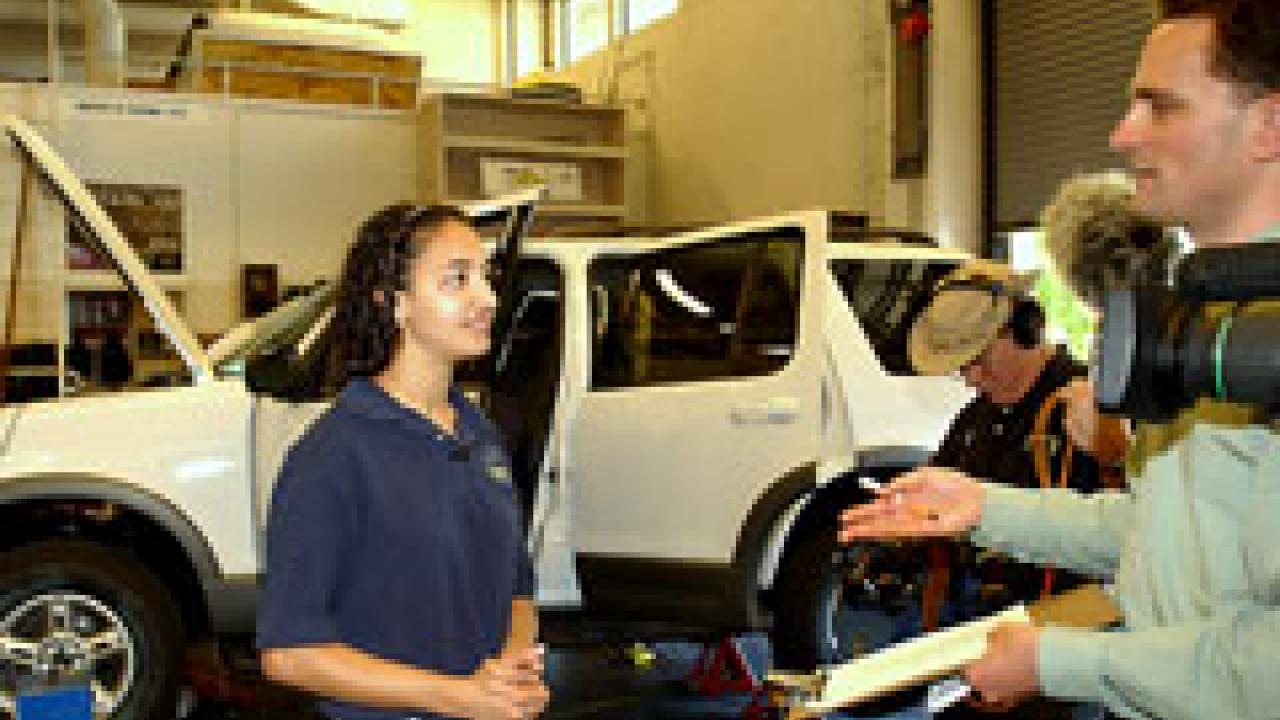University of California, Davis, students are among 15 top North American university engineering schools competing to turn a 2002 Ford Explorer into a low-emissions vehicle with at least 25 percent higher fuel economy -- without sacrificing performance, utility, safety and affordability.
UC Davis' entry to the 2002 FutureTruck competition, Yosemite, is a "plug-in" hybrid electric vehicle. An onboard battery and electric motors power the vehicle during low speed city driving and on trips up to 50 miles. A small, fuel-efficient gasoline engine powers the vehicle for extended highway driving. Yosemite's batteries can be charged at night using inexpensive off-peak electricity, or it can be driven indefinitely stopping only to refill the fuel tank.
Using electricity from the wall plug to power the vehicle is extremely efficient and results in doubling fuel economy and reducing tailpipe emissions to below California's strictest Super Ultra Low Emission Vehicle (SULEV) standards. For people concerned about global warming, "plugging-in" reduces Yosemite's carbon dioxide emissions below that of other, much smaller hybrid electric vehicles that cannot be plugged in.
FutureTruck is a joint government-industry project created by DOE to explore alternative propulsion systems and fuels through student competition. The program's goal is to help raise the environmental performance of popular SUVs while keeping the amenities and features that have made them so popular. Ford has taken over the program from General Motors Corp. as the automotive manufacturer sponsor, joining more than ten other government and industry sponsors who will support the final two years of the four-year program.
The Ford Motor Company is providing a new 2002 Explorer, $10,000, and engineering consulting for each team. The Department of Energy (DOE), through its Argonne National Laboratory facility, will provide competition management, staffing, team evaluation, and technical and financial assistance.
During the 2001 FutureTruck Competition, UC Davis won first place overall with Sequoia, a modified 2000 Chevrolet Suburban. Sequoia achieved a measured fuel economy of 27.2 mpg and also received first place in the telematics, oral presentation and vehicle modeling awards.
FutureTruck 2002 is scheduled for June 11-21, 2002. Events will be held at Ford's Arizona Proving Ground in Yucca, Ariz.; the California Air Resources Board in El Monte, Calif.; and the California Motor Speedway in Fontana, Calif. The teams will then travel to Los Angeles for a vehicle display and awards ceremony June 21 at the Regent Beverly Wilshire Hotel at 8 p.m.
The 15 competing universities for FutureTruck 2002 include: California Polytechnic State University-San Louis Obispo; Cornell University; Georgia Institute of Technology; Michigan Technological University; The Ohio State University; Pennsylvania State University; Texas Tech University; University of Alberta; University of California, Davis; University of Idaho; University of Maryland; University of Tennessee; University of Wisconsin-Madison; Virginia Tech; and West Virginia University.
Additional information about the FutureTruck 2002 program is available on the Web at http://www.futuretruck.org and http://www.team-fate.net.
Media Resources
Andy Fell, Research news (emphasis: biological and physical sciences, and engineering), 530-752-4533, ahfell@ucdavis.edu
Andrew Frank, UC Davis HEV Center, (530) 752-8120, aafrank@ucdavis.edu
Rob Kamisky, UC Davis HEV Center, (530) 752-1895, rjkamisky@ucdavis.edu
